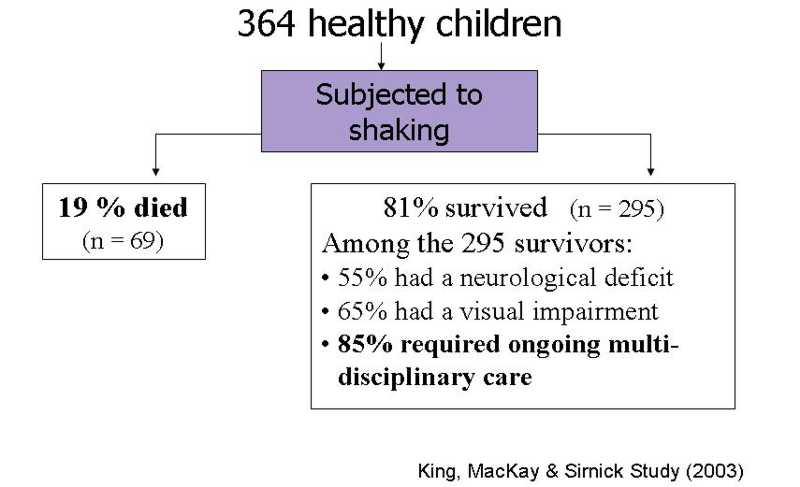What is Shaken Baby Syndrome (SBS)?
Shaken Baby Syndrome (SBS) is the term used to describe the injuries that result from roughly shaking an infant or young child by the arms, chest, or shoulders, causing the head to whiplash back and forth. In many cases, the baby is thrown or slammed down onto a surface at the end of the shaking.
The injuries that characterize a violent shaking are:
- brain damage
- bleeding in and around the brain (brain hemorrhage)
- bleeding in the backs of the eyes (retinal hemorrhage)
- sometimes broken ribs or other bones
Often there are no marks on the outside of the baby’s body. Shaking has its most serious effects on the brain because it causes the brain, the membrane and the skull to move at different speeds in different directions. This can cause tearing or shearing of the blood vessels between the brain and the skull. The resulting brain injury can lead to permanent disabilities like blindness, paralysis, growth and development disabilities, mental disabilities and even death. Play activities like being bounced on a knee or swinging in an infant seat do not cause the serious injuries seen in cases of Shaken Baby Syndrome [1].
How serious is Shaken Baby Syndrome?
A Canadian study, led by Dr. Jim King in Ottawa, identified 364 SBS victims who had been admitted to 11 children’s hospitals in Canada between 1988 and 1998. This diagram provides a summary of the outcome for the children in King’s study:

The researchers contend that the number of SBS cases identified in their study represent “only the tip of the iceberg”[2]. The incidence of SBS is likely significantly underestimated due to misdiagnoses and under-reporting. Cases of SBS may have been misdiagnosed as Sudden Infant Death Syndrome (SIDS), birth injury, or in mild SBS cases, as a viral illness. SBS accounts for some of the most devastating cases of child abuse. SBS is the most common cause of death among abused children, 0 to 3 years old. Many survivors suffer life-long physical and/or mental disabilities. The pain of SBS is not limited to the abused child. The death or serious injury of a child is also life-altering for family members. Parents, siblings, grandparents, even perpetrators, are victims as well. SBS is a serious problem. It is, by far, preferable to prevent SBS than to treat it.
Why would anyone shake a baby?
Violently shaking an infant is not a random act committed by a stranger. Usually, shaking a baby is an impulsive act, often by an exhausted or frustrated parent or caregiver. It could happen to anyone. SBS cases can occur in any cultural or socio-economic group. Factors such as sole caregiving, mental illness, substance abuse, and inadequate knowledge of child development all increase the risk. The most commonly identified perpetrator of SBS is a young father or father figure, such as a mother’s boyfriend. Females may be just as likely to shake as males, but since women generally have less strength the SBS cases they cause may be less serious and therefore less likely to be diagnosed. Reasons for shaking a baby or child include toileting mistakes, sleeping problems, or feeling that the child is not listening to the caregiver. The most common reason given for shaking a baby is that the baby wouldn’t stop crying or fussing.
Click here to view a Professional Development Session on the following topics:
- Shaken Baby Syndrome
- Risk factors
- The link between crying and shaking
- What constitutes normal infant crying
- Alberta SBS Prevention Campaign and resources
[1] Hoffman, J.M. (2005). A case of Shaken Baby Syndrome after discharge from the newborn intensive care unit. Advances in Neonatal Care, 5(3), 135-146.
[2] King ,W.J., MacKay, M., Sirnick, A., with the Canadian Shaken Baby Study Group (2003). Shaken Baby Syndrome in Canada: clinical Characteristics and outcomes of Hospital Cases. Canadian Medical Association or its licensors Jan 21, 168 (2), 155-159.
